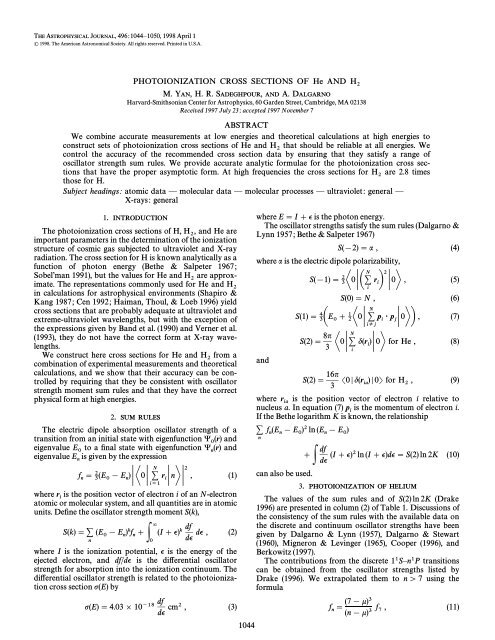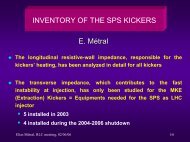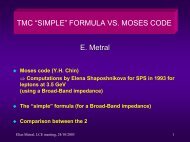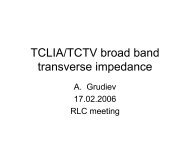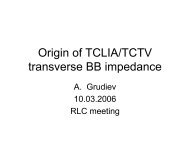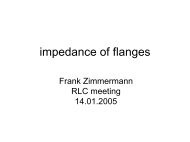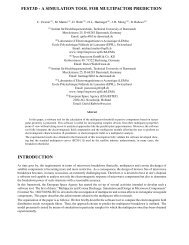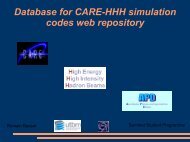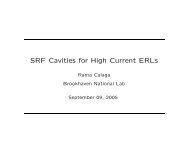Photoionization Cross Sections of He and H2
Photoionization Cross Sections of He and H2
Photoionization Cross Sections of He and H2
Create successful ePaper yourself
Turn your PDF publications into a flip-book with our unique Google optimized e-Paper software.
THE ASTROPHYSICAL JOURNAL, 496:1044È1050, 1998 April 1<br />
( 1998. The American Astronomical Society. All rights reserved. Printed in U.S.A.<br />
PHOTOIONIZATION CROSS SECTIONS OF <strong>He</strong> AND H 2<br />
M. YAN, H. R. SADEGHPOUR, AND A. DALGARNO<br />
Harvard-Smithsonian Center for Astrophysics, 60 Garden Street, Cambridge, MA 02138<br />
Received 1997 July 23; accepted 1997 November 7<br />
ABSTRACT<br />
We combine accurate measurements at low energies <strong>and</strong> theoretical calculations at high energies to<br />
construct sets <strong>of</strong> photoionization cross sections <strong>of</strong> <strong>He</strong> <strong>and</strong> H that should be reliable at all energies. We<br />
control the accuracy <strong>of</strong> the recommended cross section data 2<br />
by ensuring that they satisfy a range <strong>of</strong><br />
oscillator strength sum rules. We provide accurate analytic formulae for the photoionization cross sections<br />
that have the proper asymptotic form. At high frequencies the cross sections for H are 2.8 times<br />
those for H.<br />
2<br />
Subject headings: atomic data È molecular data È molecular processes È ultraviolet: general È<br />
X-rays: general<br />
where E \ I ] v is the photon energy.<br />
1. INTRODUCTION<br />
p(E)\4.03 ] 10~18 df<br />
dv cm2 , (3) (7 [ k)3<br />
f \ n (n [ k)3 f 7 , (11)<br />
The oscillator strengths satisfy the sum rules (Dalgarno &<br />
The photoionization cross sections <strong>of</strong> H, H , <strong>and</strong> <strong>He</strong> are<br />
2 Lynn 1957; Bethe & Salpeter 1967)<br />
important parameters in the determination <strong>of</strong> the ionization<br />
structure <strong>of</strong> cosmic gas subjected to ultraviolet <strong>and</strong> X-ray<br />
S([2) \ a , (4)<br />
radiation. The cross section for H is known analytically as a<br />
where a is the electric dipole polarizability,<br />
function <strong>of</strong> photon energy (Bethe & Salpeter 1967;<br />
SobelÏman 1991), but the values for <strong>He</strong> <strong>and</strong> H are approx-<br />
2<br />
T<br />
S([1) \ 2 0<br />
KA N ; ri<br />
B2K 0<br />
U , (5)<br />
imate. The representations commonly used for <strong>He</strong> <strong>and</strong> H 3 2<br />
in calculations for astrophysical environments (Shapiro &<br />
i<br />
Kang 1987; Cen 1992; Haiman, Thoul, & Loeb 1996) yield<br />
S(0) \ N , (6)<br />
cross sections that are probably adequate at ultraviolet <strong>and</strong> A<br />
extreme-ultraviolet wavelengths, but with the exception <strong>of</strong><br />
S(1) \ 4 E0<br />
T<br />
] 1 0<br />
K N ; pi<br />
K<br />
Æ p 0<br />
UB , (7)<br />
3 2 j<br />
the expressions given by B<strong>and</strong> et al. (1990) <strong>and</strong> Verner et al.<br />
iEj<br />
(1993), they do not have the correct form at X-ray wave- T<br />
S(2) \ 8n 0<br />
K N ; d(ri ) 0 for <strong>He</strong> , (8)<br />
lengths.<br />
3<br />
We construct here cross sections for <strong>He</strong> <strong>and</strong> H from a<br />
i<br />
2<br />
combination <strong>of</strong> experimental measurements <strong>and</strong> theoretical<br />
<strong>and</strong><br />
calculations, <strong>and</strong> we show that their accuracy can be controlled<br />
by requiring that they be consistent with oscillator<br />
strength moment sum rules <strong>and</strong> that they have the correct<br />
S(2) \ 16n<br />
3 S0 o d(r ia ) o 0T for H 2 , (9)<br />
physical form at high energies.<br />
where r is the position vector <strong>of</strong> electron i relative to<br />
ia<br />
nucleus a. In equation (7) p is the momentum <strong>of</strong> electron i.<br />
i<br />
2. SUM RULES<br />
If the Bethe logarithm K is known, the relationship<br />
The electric dipole absorption oscillator strength <strong>of</strong> a ; f (E [ E )2 ln n n 0<br />
transition from an initial state with eigenfunction ( (r) <strong>and</strong><br />
eigenvalue E to a Ðnal state with eigenfunction ( 0<br />
n<br />
(r) <strong>and</strong><br />
eigenvalue E 0<br />
is given by the expression<br />
n<br />
n KT K N<br />
f \ 2(E [ E ) 0 ; ri<br />
K (E [ E ) n 0<br />
] df (I ] v)2 ln (I ] v)dv \ S(2) ln 2K<br />
dv<br />
UK2 n , (1) can also be used.<br />
n 3 0 n<br />
i/1<br />
3. PHOTOIONIZATION OF HELIUM<br />
(10)<br />
where r is the position vector <strong>of</strong> electron i <strong>of</strong> an N-electron<br />
atomic or i<br />
The values <strong>of</strong> the sum rules <strong>and</strong> <strong>of</strong> S(2) ln 2K (Drake<br />
molecular system, <strong>and</strong> all quantities are in atomic<br />
units. DeÐne the oscillator strength 1996) are presented in column (2) <strong>of</strong> Table 1. Discussions <strong>of</strong><br />
moment S(k),<br />
the consistency <strong>of</strong> the sum rules with the available data on<br />
= df<br />
the discrete <strong>and</strong> continuum oscillator strengths have been<br />
S(k) \ ; (E [ E )kf ] (I ] v)k dv , (2)<br />
0 n n dv<br />
given by Dalgarno & Lynn (1957), Dalgarno & Stewart<br />
n<br />
0<br />
(1960), Migneron & Levinger (1965), Cooper (1996), <strong>and</strong><br />
where I is the ionization potential, v is the energy <strong>of</strong> the<br />
ejected electron, <strong>and</strong> df/dv is the di†erential oscillator<br />
strength for absorption into the ionization continuum. The<br />
di†erential oscillator strength is related to the photoionization<br />
cross section p(E)by<br />
Berkowitz (1997).<br />
The contributions from the discrete 11SÈn1P transitions<br />
can be obtained from the oscillator strengths listed by<br />
Drake (1996). We extrapolated them to n [ 7 using the<br />
formula<br />
1044
PHOTOIONIZATION CROSS SECTIONS OF <strong>He</strong> AND H 2<br />
1045<br />
TABLE 1<br />
HELIUM SUM RULES<br />
Sum Rule Exact Discrete 24.6È280 eV Resonances 0.28È2 keV 2È8 keV 8ÈO keV Total<br />
(1) (2) (3) (4) (5) (6) (7) (8) (9)<br />
S([2).......... 1.3832 0.6495 0.7267 0.0027 0.0001 . . . . . . 1.379<br />
S([1).......... 1.5050 0.5234 0.9678 0.0063 0.0015 . . . . . . 1.499<br />
S(0) ............ 2 0.4229 1.5242 0.0147 0.025 . . . . . . 1.987<br />
S(1) ............ 4.0837 0.3426 3.179 0.034 0.3996 0.03395 0.006 3.995<br />
S(2) ............ 30.33 0.28 9.853 0.08 9.035 4.396 5.686 29.33<br />
S(2)ln 2K ...... 111.5 [0.06 13.21 0.08 29.54 21.71 44.46 108.9<br />
where k \[0.012 is the limiting value <strong>of</strong> the quantum<br />
defect for the 1P series. Their contributions to the individual<br />
sums are given in column (3) <strong>of</strong> Table 1. The discrete oscillator<br />
strengths sum to 0.4229, in satisfactory agreement<br />
with an experimentally derived sum <strong>of</strong> 0.431 ^ 0.02 (Chan<br />
et al. 1991).<br />
From the continuity <strong>of</strong> the oscillator strength across the<br />
ionization threshold, we obtain from equation (11) a value<br />
<strong>of</strong> 1.84 for df/dv at the spectral head, corresponding to a<br />
threshold photoionization cross section <strong>of</strong> 7.42 ] 10~18<br />
cm2 at a photon energy <strong>of</strong> 24.587 eV. The value is in close<br />
agreement with several theoretical calculations <strong>and</strong> experimental<br />
measurements (Samson et al. 1994b). Samson et al.<br />
(1994b) recommend a threshold cross section <strong>of</strong><br />
7.40 ] 10~18 cm2, <strong>and</strong> Bizau & Wuilleumier (1995) recommend<br />
7.42 ] 10~18 cm2.<br />
Reliable measurements exist for photon energies up to<br />
120 eV. Samson et al. (1994b) <strong>and</strong> Bizau & Wuilleumier<br />
(1995) extended them to 280 eV with an extrapolation based<br />
on several earlier sources <strong>of</strong> experimental data. The recommended<br />
values are listed in Table 2. They are in satisfactory<br />
agreement with theoretical calculations (Bell & Kingston<br />
1971; Hino et al. 1993; Meyer & Greene 1994; Decleva,<br />
Lisini, & Venuti 1994; Tang & Shimamura 1995; Pont &<br />
Shakeshaft 1995; Venuti, Decleva, & Lisini 1996). We list in<br />
column (4) <strong>of</strong> Table 1 the contributions to the sum rules. In<br />
the same energy region are absorptions into doubly excited<br />
resonance states (nsmp), which introduce structural features<br />
into the variation <strong>of</strong> the cross section with photon energy.<br />
Although resonance parameters, energy, width, <strong>and</strong> proÐle<br />
have been calculated by a number <strong>of</strong> investigators (Ho<br />
1995; Venuti et al. 1996; Sadeghpour & Cavagnero 1993;<br />
Sanchez & Martin 1991; Tang et al. 1992), explicit values<br />
for the resonant contributions to di†erent oscillator sum<br />
rules have not been available. A recent calculation<br />
(Sadeghpour 1998) shows that they contribute negligibly for<br />
m º 5 <strong>and</strong> n º 6. The doubly excited state contributions to<br />
the sum rules obtained by integrating over the calculated<br />
resonance proÐles are given in column (5) <strong>of</strong> Table 1. With<br />
their inclusion, the sum rules S([2) <strong>and</strong> S([1) to which<br />
higher energies yield negligible amounts are satisÐed to<br />
within 0.5%.<br />
The photoionization cross sections at higher energies are<br />
less certain. The measurements may be a†ected by the presence<br />
<strong>of</strong> impurities in the gas <strong>and</strong>, at energies above 1.5 keV,<br />
by Compton ionization (McCrary, Looney, & Atwater<br />
1970; Samson, Greene, & Bartlett 1993; Samson et al.<br />
1994a; see also ° 5). From a review <strong>of</strong> the theoretical <strong>and</strong><br />
experimental data, Samson et al. (1994b) have constructed a<br />
set <strong>of</strong> photoionization cross sections at energies between<br />
280 eV <strong>and</strong> 8 keV. Subsequently, several calculations <strong>of</strong> the<br />
cross sections have been reported (Hino 1993; Andersson &<br />
Burgdoerfer 1993; Forrey et al. 1997) using di†erent<br />
methods. The calculations are consistent with the limiting<br />
nonrelativistic form,<br />
df<br />
dv D 21@2Z2S(2) E~7@2 (12)<br />
n<br />
(Kabir & Salpeter 1957; Dalgarno & Stewart 1960), which,<br />
on using the value <strong>of</strong> S(2) in Table 1 <strong>and</strong> converting from<br />
atomic units, becomes, for the photoionization cross<br />
section,<br />
p(E) D 733.0 barns . (13)<br />
E(keV)7@2<br />
We constructed a set <strong>of</strong> cross sections by merging the highenergy<br />
data <strong>of</strong> Andersson & Burgdoerfer (1993) <strong>and</strong> Forrey<br />
et al. (1997), computed in the acceleration gauge, with the<br />
low-energy results <strong>of</strong> Samson et al. (1994b). The corresponding<br />
contributions to the sum rules are listed in<br />
columns (6), (7), <strong>and</strong> (8) <strong>of</strong> Table 1 for energies between 280<br />
eV <strong>and</strong> 2 keV, 2 <strong>and</strong> 8 keV, <strong>and</strong> greater than 8 keV, respectively.<br />
The sums <strong>of</strong> all the contributions are given in column (9).<br />
There are di†erences <strong>of</strong> up to 3% from the exact values that<br />
can be sensibly remedied only by increasing the cross sections<br />
in the lower energy region between 170 eV <strong>and</strong> 2 keV.<br />
We modiÐed them accordingly so that a smoothly varying<br />
cross section results. It is illustrated in Figure 1 as the<br />
product <strong>of</strong> E7@2p(E) with E in units <strong>of</strong> the ionization poten-<br />
<strong>Cross</strong> Section (barn)*(Energy/I th<br />
) 7/2<br />
10 9<br />
10 8<br />
10 7<br />
<strong>He</strong><br />
H<br />
10 6<br />
10 0 10 1 10 2 10 3 10 4<br />
Energy/I th<br />
FIG. 1.ÈRecommended photoionization cross sections in the form<br />
(E/I )7@2p(E), where I is the respective ionization potential for H, <strong>He</strong>, <strong>and</strong><br />
H . th<br />
Also shown is 2 ] th<br />
the hydrogen cross section.<br />
2<br />
2H<br />
H 2
1046 YAN, SADEGHPOUR, & DALGARNO Vol. 496<br />
TABLE 2<br />
TOTAL PHOTOIONIZATION CROSS SECTIONS OF <strong>He</strong> FROM 24.6 TO 300 eV<br />
p(Mbarn) Bizau & p(Mbarn)<br />
E(eV) (Samson et al. 1994a) Wuilleumier 1995 (Present Work)<br />
24.6 ...... 7.400 7.420 7.460<br />
26........ 6.790 7.800 6.820<br />
28........ 6.050 6.050 6.080<br />
30........ 5.380 5.380 5.440<br />
32........ 4.820 4.820 4.870<br />
34........ 4.320 4.320 4.360<br />
36........ 3.880 3.880 3.910<br />
38........ 3.500 3.500 3.530<br />
40........ 3.160 3.160 3.190<br />
42........ 2.860 2.850 2.890<br />
44........ 2.600 2.600 2.630<br />
46........ 2.380 2.380 2.410<br />
48........ 2.190 2.190 2.200<br />
50........ 2.020 2.010 2.020<br />
52........ 1.850 1.840 1.860<br />
54........ 1.710 1.710 1.720<br />
56........ 1.630 1.620 1.590<br />
58........ 1.580 1.560 1.470<br />
64........ 1.190 1.200 1.180<br />
66........ 1.150 1.150 1.100<br />
68........ 1.060 1.060 1.030<br />
70........ 0.975 0.980 0.965<br />
72........ 0.907 0.910 0.903<br />
74........ 0.842 0.850 0.847<br />
76........ 0.788 0.800 0.794<br />
78........ 0.738 0.750 0.746<br />
80........ 0.693 0.700 0.702<br />
82........ 0.652 0.660 0.660<br />
84........ 0.614 0.622 0.622<br />
86........ 0.578 0.586 0.587<br />
88........ 0.546 0.555 0.554<br />
90........ 0.516 0.523 0.523<br />
92........ 0.488 0.494 0.495<br />
94........ 0.464 0.469 0.469<br />
96........ 0.438 0.442 0.444<br />
98........ 0.416 0.421 0.421<br />
100 ...... 0.3930 0.3960 0.3990<br />
105 ...... 0.3450 0.3470 0.3510<br />
110 ...... 0.3060 0.3080 0.3100<br />
115 ...... 0.2730 0.2760 0.2750<br />
120 ...... 0.2440 0.2480 0.2450<br />
125 ...... 0.2180 0.2280 0.2190<br />
130 ...... 0.1960 0.2070 0.1970<br />
135 ...... 0.1770 0.1870 0.1770<br />
140 ...... 0.1600 0.1710 0.1600<br />
145 ...... 0.1440 0.1550 0.1450<br />
150 ...... 0.1310 0.1370 0.1320<br />
155 ...... 0.1180 0.1240 0.1200<br />
160 ...... 0.1080 0.1150 0.1090<br />
165 ...... 0.0980 0.1040 0.1010<br />
170 ...... 0.0894 0.0940 0.0920<br />
175 ...... 0.0826 0.0870 0.0850<br />
180 ...... 0.0760 0.0800 0.0782<br />
185 ...... 0.0700 0.0730 0.0722<br />
190 ...... 0.0643 0.0670 0.0667<br />
195 ...... 0.0593 0.0620 0.0618<br />
200 ...... 0.0550 0.0580 0.0574<br />
205 ...... 0.0510 0.0530 0.0533<br />
210 ...... 0.0474 0.0500 0.0497<br />
215 ...... 0.0440 0.0460 0.0463<br />
220 ...... 0.0409 0.0430 0.0433<br />
225 ...... 0.0382 0.0397 0.0404<br />
230 ...... 0.0356 0.0369 0.0379<br />
235 ...... 0.0335 0.0340 0.0355<br />
240 ...... 0.0315 0.0329 0.0333<br />
245 ...... 0.0295 0.0309 0.0313<br />
250 ...... 0.0277 0.0287 0.0295<br />
255 ...... 0.0261 0.0267 0.0278<br />
260 ...... 0.0245 0.0253 0.0262<br />
270 ...... 0.0218 0.0227 0.0234<br />
280 ...... 0.0194 0.0196 0.0209<br />
300 ...... 0.0155 0.0162 0.0169<br />
tial <strong>of</strong> helium. A detailed comparison with the recommendations<br />
<strong>of</strong> Samson et al. (1994b) <strong>and</strong> Bizau & Wuillemier<br />
(1994) is given in Table 2. The revised sum rules are presented<br />
in Table 3, where they are compared to those <strong>of</strong> Table 1.<br />
The agreement with the sum rules is now within 0.5%. If we<br />
use the recent experimental photoionization data <strong>of</strong> Azuma<br />
et al. (1995) in the range <strong>of</strong> energies 3È14 keV, we obtain<br />
results for the S(k) sum rules that agree with the values given<br />
in Table 3 for k \ 2, but the Azuma et al. (1995) data underestimate<br />
S(2) <strong>and</strong> S(2) ln 2K by as much as 6%. The Azuma<br />
et al. (1995) photoionization data are obtained by subtracting<br />
the theoretical coherent <strong>and</strong> incoherent scattering cross<br />
sections compiled by Hubbell et al. (1975), which dominate<br />
for energies higher than about 5 keV, from the measured<br />
total attenuation cross sections. The data do not Ðt the<br />
asymptotic behavior with energy given in equation (13).<br />
The modiÐed photoionization cross sections are reproduced<br />
by the analytical formula<br />
A<br />
p (E) \ 733.0 6 a 1 ] ;<br />
<strong>He</strong> E(keV)7@2 xn@2B n barns , (14)<br />
n/1<br />
where x \ E/24.58 eV <strong>and</strong> a are parameters given in Table<br />
n<br />
4. The resonance structures calculated by Sadeghpour<br />
(1997) may be superposed, but their e†ects are small.<br />
The Ðt in equation (14) satisÐes the oscillator strength<br />
sum rules very accurately <strong>and</strong> has the proper asymptotic<br />
form with energy. The expansion coefficients in Table 4<br />
have alternating signs, suggestive <strong>of</strong> a decaying exponential<br />
form. We Ðtted the data alternatively to the following form:<br />
p <strong>He</strong><br />
(E) \ 7.4 ] 106[a 1<br />
x~s ] (1 [ a 1<br />
)x~(s`1)]<br />
] 733.0<br />
E(keV)7@2 (1 ] a 2 x~1@2e~a3x~1@2 ) barns , (15)<br />
where the Ðrst two terms were suggested by Seaton (1958)<br />
for energies near threshold. The Ðtting parameters are given<br />
in Table 5. The four-term polynomial Ðt in x~1@2 in place <strong>of</strong><br />
the exponential term produces an alternating series whose<br />
TABLE 3<br />
VALUES OF SUM RULES FOR <strong>He</strong><br />
Value S([2) S([1) S(0) S(1) S(2) S(2) ln 2K<br />
Exact .......... 1.383 1.505 2 4.084 30.3 111.5<br />
Empirical ...... 1.383 1.504 1.996 4.063 30.2 111.2<br />
TABLE 4<br />
FITTING PARAMETERS FOR HELIUM PHOTOIONIZATION CROSS SECTION:<br />
EQUATION (14)<br />
a 1<br />
a 2<br />
a 3<br />
a 4<br />
a 5<br />
a 6<br />
[4.7416 14.8200 [30.8678 37.3584 [23.4585 5.9133<br />
TABLE 5<br />
FITTING PARAMETERS FOR HELIUM<br />
PHOTOIONIZATION CROSS SECTION:<br />
EQUATION (15)<br />
a 1<br />
s a 2<br />
a 3<br />
7.3861 3.9119 [3.2491 1.1783
No. 2, 1998 PHOTOIONIZATION CROSS SECTIONS OF <strong>He</strong> AND H 2<br />
1047<br />
<strong>Cross</strong> Section(barn)*(Energy (eV)) 7/2<br />
10 14<br />
10 13<br />
10 12<br />
10 11<br />
<strong>He</strong><br />
NIST − 97<br />
<strong>He</strong>nke−93<br />
Present<br />
10 1 10 2 10 3 10 4 10 5<br />
Photon Energy (eV)<br />
FIG. 2.ÈRecommended photoionization cross section for <strong>He</strong> in the<br />
form E7@2p(E). Also shown are the data <strong>of</strong> <strong>He</strong>nke et al. (1993) <strong>and</strong> NIST<br />
(1997). The NIST results do not asymptotically tend to a constant.<br />
(According to a note on X-ray attenuation databases at NIST 1997, the<br />
photoabsorption results given there for helium are unreliable.)<br />
coefficients are approximately equal to the expansion coefficients<br />
for the exponential, [a , a2/2, [a3/3!.<br />
3 3 3<br />
Double photoionization <strong>of</strong> helium l ] <strong>He</strong> ] <strong>He</strong>2` ] 2e<br />
is included in the sum rules. It has received considerable<br />
attention (Ishihara, Hino, & McGuire 1991; Levin et al.<br />
1991, 1993; Bartlett et al. 1992; Dalgarno & Sadeghpour<br />
1992; Andersson & Burgdoerfer 1993; Kornberg & Miraglia<br />
1993; Hino 1993; Hino et al. 1993; Proulx & Shakeshaft<br />
1993; Berrah et al. 1993; Teng & Shakeshaft 1993,<br />
1994; Fan, Sadeghpour, & Dalgarno 1994; Azuma et al.<br />
1995; Sadeghpour 1996), because it provides a direct<br />
measure <strong>of</strong> the e†ect <strong>of</strong> electron correlation. At high energies,<br />
the ratio <strong>of</strong> the cross sections for double to single<br />
ionization tends to a constant value <strong>of</strong> 0.0164 (Dalgarno &<br />
Sadeghpour 1992; Forrey et al. 1995). As the energy<br />
decreases below 1 keV, the ratio increases to a maximum <strong>of</strong><br />
about 0.04 at 120 eV <strong>and</strong> then decreases sharply to zero at<br />
the threshold <strong>of</strong> 79.0 eV (Samson, Bartlett, & <strong>He</strong> 1992).<br />
In Figure 2 we show also the data from <strong>He</strong>nke, Gullikson,<br />
& Davis (1993) <strong>and</strong> NIST (1997). We believe that in the<br />
energy range from threshold to 600 eV, our cross sections<br />
have an uncertainty <strong>of</strong> less than 2%. The error in the photoabsorption<br />
cross sections at higher energies should be<br />
no more than 5% at any energy, <strong>and</strong> it is on average less<br />
than 2%.<br />
4. PHOTOIONIZATION OF MOLECULAR HYDROGEN<br />
Samson & Haddad (1994) have measured the photoabsorption<br />
cross sections <strong>of</strong> H at photon energies between 18<br />
<strong>and</strong> 113 eV to within an uncertainty 2<br />
<strong>of</strong> ^3%. There have<br />
been earlier measurements down to the threshold energy <strong>of</strong><br />
15.4 eV (Cook & Metzger 1964; Lee, Carlson, & Judge<br />
1976). The threshold region is complicated by the presence<br />
<strong>of</strong> autoionizing resonances arising from vibrationally<br />
excited Rydberg states whose detailed structure has not<br />
been fully analyzed (Dehmer & Chupka 1976; Dehmer et al.<br />
1992; Jungen, Pratt, & Ross 1995). Theoretical calculations<br />
(Ford, Docken, & Dalgarno 1975; Flannery, Tai, & Albritton<br />
1977; Cacelli, Moccia, & Rizzo 1993) yield an average<br />
cross section increasing from 1 ] 10~18 cm2 at threshold to<br />
1 ] 10~17 cm2 at 18 eV, where it agrees with the measurements<br />
<strong>of</strong> Samson & Haddad (1994). The increasing average<br />
cross section is a reÑection <strong>of</strong> the Franck-Condon overlap<br />
<strong>of</strong> the initial vA \ 0 vibrational wave function <strong>of</strong> H with the<br />
Ðnal v@ vibrational wave function <strong>of</strong> H The 2<br />
Franck-<br />
Condon factors maximize at v@ \ 2. 2`.<br />
Samson & Haddad (1994) have measured the cross sections<br />
between 18 <strong>and</strong> 113 eV <strong>and</strong> recommend cross sections<br />
out to 300 eV, which they believe to be uncertain by no<br />
more than 4%. Theoretical calculations (Ford et al. 1975;<br />
Flannery et al. 1977; OÏNeill & Reinhardt 1978) do not<br />
extend beyond 37 eV, except for the evaluation <strong>of</strong> Cooper<br />
(1974) <strong>and</strong> Sadeghpour & Dalgarno (1993) <strong>of</strong> the highenergy<br />
limiting nonrelativistic formula<br />
p (E) D 45.6 barns . (16)<br />
<strong>H2</strong> E(keV)7@2<br />
We attempt to make use <strong>of</strong> the sum rules to extend the cross<br />
sections <strong>of</strong> Samson & Haddad (1994) to the high-energy<br />
region. Sum rules for H have been obtained within the<br />
2<br />
Born-Oppenheimer approximation over an extended range<br />
<strong>of</strong> internuclear distance R by Wolniewicz (1993). The sums<br />
vary slowly with R in the Franck-Condon region, which<br />
extends from 1a to 2a , <strong>and</strong> the vibrational averages for<br />
0 0<br />
vA \ 0 do not di†er importantly from the values at the equilibrium<br />
internuclear distance <strong>of</strong> 1.4a . The sum rules are<br />
0<br />
given in Table 6. The value <strong>of</strong> ln 2K calculated by<br />
Wolniewicz (1993) makes use <strong>of</strong> an approximate representation<br />
<strong>of</strong> S(k) as a function <strong>of</strong> k (Dalgarno 1960; Garcia 1966;<br />
Bishop & Cheung 1978) <strong>of</strong> uncertain accuracy.<br />
Because <strong>of</strong> the nuclear motion, the near-threshold photoionization<br />
cross sections cannot be transformed directly<br />
into the electronic di†erential oscillator strengths that enter<br />
into the sum rules. Absorption occurs preferentially into the<br />
v@ \ 2 level <strong>of</strong> H once it becomes energetically accessible.<br />
As the photon energy 2`<br />
exceeds the vibrational energies, the<br />
TABLE 6<br />
VALUES OF SUM RULES FOR H 2<br />
Sum Rulea Exact Discrete 15.4È18 eV 18È115 eV 115È300 eV 300ÈO eV Total<br />
S([2) .......... 5.180 3.784 0.315 1.018 . . . . . . 5.117<br />
S([1) .......... 3.036 1.884 0.195 0.900 0.003 . . . 2.982<br />
S(0)............. 2 0.943 0.121 0.873 0.014 0.002 1.954<br />
S(1)............. 1.701 0.474 0.075 0.981 0.088 0.041 1.659<br />
S(2)............. 3.851 0.239 0.047 1.359 0.577 1.578 3.800<br />
S(2)ln(2K) ...... 8.911 [0.163 [0.022 0.638 1.108 7.405 8.966<br />
a These are the values <strong>of</strong> the electronic sum rules evaluated at the equilibrium separation. The value <strong>of</strong> S(2) ln 2K<br />
is an approximate estimate.
1048 YAN, SADEGHPOUR, & DALGARNO Vol. 496<br />
sums over the vibrational energy levels approach unity <strong>and</strong><br />
TABLE 7<br />
cross section in the form x7@2p(E) as a function <strong>of</strong> the scaled cross section (Jackson 1975, p. 679):<br />
energy x <strong>and</strong> compares it to the similar cross sections for H<br />
<strong>and</strong> <strong>He</strong>. Above 20 eV, the possible error in the cross sections<br />
B<br />
p (E) \ nr2 A4 for H should not exceed 5%.<br />
T e 3 ] cos h c ] cos3 h c , (22)<br />
3<br />
2<br />
the relationship (3) can be applied to the cross section data.<br />
TOTAL PHOTOIONIZATION CROSS SECTIONS OF H FROM 2<br />
We assume that the relationship is valid for photon energies<br />
100 TO 300 eV<br />
above 18 eV.<br />
p(Mbarn)<br />
p(Mbarn)<br />
Estimates <strong>of</strong> the contributions <strong>of</strong> photoionization to the<br />
E(eV) (Samson & Haddad 1994) (Present Work)<br />
sum rules below 18 eV can be obtained from the calculations<br />
<strong>of</strong> Ford et al. (1975). After correcting for the Franck-<br />
100...... 0.04790 0.04762<br />
105...... 0.04130 0.04122<br />
Condon overlap, we infer a nearly constant electronic<br />
110...... 0.03570 0.03598<br />
oscillator strength df/dv <strong>of</strong> 2.7 at threshold, where v is measured<br />
in atomic units. This modiÐed value is a factor <strong>of</strong> 1.7<br />
120...... 0.02710 0.02797<br />
115...... 0.03160 0.03163<br />
times that <strong>of</strong> atomic hydrogen.<br />
125...... 0.02380 0.02485<br />
Values <strong>of</strong> the discrete oscillator strengths <strong>of</strong> the transitions<br />
from the ground state to the B1& , C1% , <strong>and</strong><br />
130...... 0.02110 0.02219<br />
135...... 0.01860 0.01989<br />
B@1& states have been calculated by OÏNeill ù<br />
& Reinhardt ù 140...... 0.01650 0.01789<br />
(1978), ù<br />
145...... 0.01480 0.01615<br />
Dressler & Wolniewicz (1985), <strong>and</strong> Komasa &<br />
150...... 0.01330 0.01462<br />
Thakkar (1994) <strong>and</strong> the transition energies by Rothenberg<br />
160...... 0.01080 0.01208<br />
170...... 0.00895 0.01009<br />
& Davidson (1967). The sum <strong>of</strong> the oscillator strengths at<br />
180...... 0.00755 0.00849<br />
the equilibrium separation is the same factor <strong>of</strong> 1.7 times the<br />
190...... 0.00640 0.00721<br />
1sÈ2p oscillator strength <strong>of</strong> H. We make little error in<br />
200...... 0.00545 0.00617<br />
assuming that the other discrete oscillator strengths <strong>of</strong> H 210...... 0.00470 0.00531<br />
are 1.7 times those for H. For the transitions we adopt a 2<br />
220...... 0.00403 0.00460<br />
230...... 0.00350 0.00401<br />
mean transition energy <strong>of</strong> 15.2 eV. The resulting discrete<br />
240...... 0.00308 0.00351<br />
contributions to the sums S(k) <strong>and</strong> S(2) ln 2K are given in<br />
250...... 0.00270 0.00309<br />
Table 6 with the contributions <strong>of</strong> df/dv between threshold<br />
260...... 0.00240 0.00273<br />
<strong>and</strong> 18 eV.<br />
270...... 0.00213 0.00243<br />
280...... 0.00190 0.00216<br />
For energies between 18 <strong>and</strong> 300 eV, we initially adopted<br />
290...... 0.00171 0.00194<br />
the cross sections recommended by Samson & Haddad<br />
300...... 0.00154 0.00174<br />
(1994), <strong>and</strong> for higher energies, cross sections with the same<br />
shape as for the hydrogen atom but scaled in magnitude to<br />
match the correct asymptotic form (eq. [16]). The resulting The fraction <strong>of</strong> ionizations that produce H` ions is<br />
values <strong>of</strong> S(2) <strong>and</strong> S(2) ln 2K were too small. To achieve important in astrophysics. Double photoionization,<br />
agreement with the sum rules, we raised the cross section at<br />
H ] l ] H` ] H` ] 2e~ , (20)<br />
300 eV from 1.54 ] 10~21 cm2 to 1.75 ] 10~21 cm2 <strong>and</strong><br />
2<br />
connected the cross sections smoothly to the measurements has a vertical threshold <strong>of</strong> 51.4 eV. The cross section has<br />
at 113 eV <strong>and</strong> to the asymptotic limit at high energies. The been measured by Dujardin et al. (1987) <strong>and</strong> Kossmann et<br />
revised sums are listed in Table 6. The agreement is close, al. (1989a, 1989b), <strong>and</strong> calculations have been reported by<br />
though, for S([2) partly fortuitous. The cross sections at Le Rouzo (1986). At 110 eV, the measured ratio <strong>of</strong> double to<br />
high energies should be reliable. They are about 2.8 times single ionization is 0.038. The asymptotic ratio is predicted<br />
those for atomic hydrogen, in agreement with the measurements<br />
<strong>of</strong> Crasemann et al. (1974) at 5.4 <strong>and</strong> 8.4 keV.<br />
The cross section for dissociative ionization,<br />
to be 0.0225 (Sadeghpour & Dalgarno 1993).<br />
Table 7 is a list <strong>of</strong> our recommended cross sections from<br />
H ] l ] H ] H` ] e~ , (21)<br />
100 to 300 eV compared to those suggested by Samson &<br />
2<br />
Haddad (1994).<br />
is complicated by the contribution <strong>of</strong> resonance states (<strong>He</strong><br />
The cross sections for the photoionization <strong>of</strong> H may be at al. 1995). It has been measured by Browning & Fryar<br />
represented analytically by<br />
2<br />
(1973), Strathdee & Browning (1976, 1979), Ito et al. (1988),<br />
Chung et al. (1993), Latimer et al. (1995), <strong>and</strong> Ito, Hall, &<br />
p (E) \ 108([37.895 ] 99.723x [ 87.227x2]25.400x3)<br />
<strong>H2</strong> Ukai (1996) for energies up to 124 eV. Its ratio to the total<br />
barns for 15.4 \ E \ 18 eV , (17) photoionization cross section increases from zero at the<br />
p (E) \ 2 ] 107(0.071x~s [ 0.673x~(s`1)<br />
threshold <strong>of</strong> 18.08 eV to 0.284 at 76 eV <strong>and</strong> then decreases<br />
<strong>H2</strong> slowly to 0.258 at 124 eV.<br />
] 1.977x~(s`2) [ 0.692x~(s`3)) barns<br />
5. COMPTON IONIZATION<br />
for 18 \ E \ 85 eV , (18)<br />
At high energies Compton ionization is a more efficient<br />
p (E) \ 45.57(1 [ 2.003/x0.5 [ 4.806/x ] 50.577/x1.5<br />
<strong>H2</strong> source <strong>of</strong> ionization than photoionization. In Compton ionization,<br />
[ 171.044/x2]231.608/x2.5 [ 81.885/x3)/E(keV)3.5<br />
the photon is not absorbed but scattered, <strong>and</strong> it<br />
barns for E [ 85 eV , (19)<br />
shares energy <strong>and</strong> momentum with the ejected electron. At<br />
high energies the bound energies <strong>of</strong> electrons in atoms or<br />
where x \ E(eV)/15.4 <strong>and</strong> s \ 0.252. We do not attempt to<br />
reproduce the structures near threshold introduced by the<br />
presence <strong>of</strong> resonance states. Figure 1 shows the resulting<br />
molecules can be ignored, <strong>and</strong> the cross sections are those<br />
for scattering by free electrons. The nonrelativistic limit <strong>of</strong><br />
the Compton ionization cross section is the Thompson
No. 2, 1998 PHOTOIONIZATION CROSS SECTIONS OF <strong>He</strong> AND H 2<br />
1049<br />
Compton <strong>Cross</strong> Section (barns)<br />
1.5<br />
1.0<br />
0.5<br />
H<br />
<strong>He</strong><br />
H 2<br />
/2<br />
H 2<br />
0.0<br />
0 20 40 60 80 100<br />
Photon Energy (keV)<br />
FIG. 3.ÈCompton ionization cross sections for H, <strong>He</strong>, <strong>and</strong> H from the<br />
compilation <strong>of</strong> Hubbell et al. (1975). For comparison, the H cross 2<br />
section<br />
per electron is also plotted. It converges to the hyrdogen 2<br />
atom cross<br />
section at high photon energies.<br />
where x \ E/I , cos h \ 1 [ (c2/E)[x/(1 [ x)], r \<br />
th c e<br />
e2/m c2 is the classical electron radius, c is the speed <strong>of</strong> light<br />
e<br />
<strong>and</strong> r2\0.07940775<br />
barns. The inclusion <strong>of</strong> retardation<br />
e<br />
e†ects causes the cross sections to diminish with increasing<br />
energy where they are accurately represented by the Kleinformula.<br />
Nishina (1929)<br />
Tables <strong>of</strong> the Compton ionization cross sections for all<br />
the elements have been compiled by Hubbell et al. (1975),<br />
where they are referred to as incoherent scattering cross<br />
sections. We reproduce in Figure 3 the Compton cross sections<br />
for H, H , <strong>and</strong> <strong>He</strong>. At high photon energies the<br />
Compton cross 2<br />
sections for <strong>He</strong> <strong>and</strong> H become similar as<br />
the ratio <strong>of</strong> the binding energies <strong>of</strong> the 2<br />
electrons to the<br />
photon energy decreases. The Compton cross sections<br />
become larger than the corresponding photoionization<br />
cross sections at 2.8, 6.5, <strong>and</strong> 3.1 keV for H, <strong>He</strong>, <strong>and</strong> H ,<br />
respectively. The ratio <strong>of</strong> the H to H Compton cross sec- 2<br />
tions is close to 2 (Hubbell et al. 1975). 2<br />
It is also possible to eject two electrons in the Compton<br />
process. There have been recent calculations (Andersson &<br />
Burgdoerfer 1993; Suric et al. 1994; Hino, Bergstrom, &<br />
Macek 1994) <strong>and</strong> experiments (Spielberger et al. 1995) that<br />
obtained the double Compton total cross sections <strong>of</strong> <strong>He</strong> for<br />
energies in the 10 keV range. The emerging theme from<br />
both theory <strong>and</strong> experiment is that the double-to-single<br />
Compton ionization ratio does not di†er signiÐcantly from<br />
0.016, the asymptotic value <strong>of</strong> the double-to-single photoionization<br />
ratio.<br />
We gratefully acknowledge the help <strong>of</strong> P. Kharchenko in<br />
the early stages <strong>of</strong> these calculations <strong>and</strong> the useful comments<br />
<strong>of</strong> the referee, D. McCammon. Support for this work<br />
was provided by a grant from the Astronomy Division <strong>of</strong><br />
the National Science Foundation AST 95-31790 <strong>and</strong> by a<br />
grant from the Physics Division for the Institute for Theoretical<br />
Atomic <strong>and</strong> Molecular Physics.<br />
REFERENCES<br />
Andersson, L. R., & Burgdoerfer, J. 1993, Phys. Rev. Lett., 71, 50<br />
Azuma, Y., Berry, H. G., Gemmell, D. S., Suleiman, J., Westerlind, M.,<br />
Sellin, I., Woicek, J. C., & Kirkl<strong>and</strong>, J. P. 1995, Phys. Rev. A, 51, 447<br />
B<strong>and</strong>, I. M., Trzhaskovshaya, M. B., Verner, D. A., & Yakovlev, D. G.<br />
1990, A&A, 237, 267<br />
Bartlett, R. J., Walsh, P. J., <strong>He</strong>, Z. X., Chung, Y., Lee, E.-M., & Samson,<br />
J. A. R. 1992, Phys. Rev. A, 46, 5574<br />
Bell, K. L., & Kingston, A. E. 1971, J. Phys. B, 4, 1308<br />
Berkowitz, J. 1997, J. Phys. B, 30, 881<br />
Berrah, N., <strong>He</strong>iser, F., Wehlitz, R., Levin, J., WhitÐeld, S. P., Viefhaus, J.,<br />
Sellin I. A., & Becker, U. 1993, Phys. Rev. A, 48, R1733<br />
Bethe, H. A., & Salpeter, E. E. 1967, Quantum Mechanics <strong>of</strong> One- <strong>and</strong><br />
Two-Electron Systems (New York: Plenum)<br />
Bishop, D. M., & Cheung, L. M. 1978, J. Phys. B, 11, 3133<br />
Forrey, R. C., Sadeghpour, H. R., Baker, J. D., Morgan, J. D., & Dalgarno,<br />
A. 1995, Phys. Rev. A, 51, 2112<br />
Forrey, R. C., Yan, Z.-C., Sadeghpour, H. R., & Dalgarno, A. 1997, Phys.<br />
Rev. Lett., 78, 3662<br />
Garcia, J. D. 1966, Phys. Rev., 14, 66<br />
Haiman, Z., Thoul, A. A., & Loeb, A. 1996, ApJ, 464, 523<br />
<strong>He</strong>, Z. X., Cutler, J. N., Southworth, S. H., Hughey, L. R., & Samson,<br />
J. A. R. 1995, J. Chem. Phys., 103, 3912<br />
<strong>He</strong>nke, B. L., Gullikson, E. M., & Davis, J. C. 1993, At. Data Nuc. Data<br />
Tables, 54, 181<br />
Hino, K. 1993, Phys. Rev. A, 47, 4845<br />
Hino, K., Bergstrom, P. M., & Macek, J. H. 1994, Phys. Rev. Lett., 72, 1620<br />
Hino, K., Ishihara, T., Shimizu, F., Toshima, N., & McGuire, J. H. 1993,<br />
Phys. Rev. A, 48, 1271<br />
Bizau, J. M., & Wuilleumier, F. J. 1995, J. Electron Spectrosc. Rel. Ho, Y. K. 1995, Chinese J. Phys., 34, 9<br />
Phenom., 71, 205<br />
Browning R., & Fryar J. 1973, J. Phys. B, 6, 364<br />
Cacelli, I., Moccia, R., & Rizzo, A. 1993, J. Chem. Phys., 98, 8742<br />
Cen, R. 1992, ApJS, 78, 341<br />
Chan, W. V., Cooper, G., & Brion, C. E. 1991, Phys. Rev. A, 44, 186<br />
Chung, Y. M., Lee, E.-M. Masuoka, T., & Samson, J. A. R. 1993, J. Chem.<br />
Phys., 99, 885<br />
Cook, G. R., & Metzger, P. H. 1964, J. Opt. Soc. Am., 54, 968<br />
Cooper, J. W. 1974, Phys. Rev. A, 9, 2236<br />
ÈÈÈ. 1996, Radiat. Phys. Chem. 47, 927<br />
Crasemann, B., Koblas, P. E., Wang, T.-C., Birdseye, H. E., & Chen, M. H.<br />
1974, Phys. Rev. A, 9, 1143<br />
Dalgarno, A. 1960, Proc. Phys. Soc. London, 76, 422<br />
Dalgarno, A., & Lynn, N. 1957, Proc. Phys. Soc. London, 70, 802<br />
Dalgarno, A., & Sadeghpour, H. R. 1992, Phys. Rev. A, 46, R3591<br />
Dalgarno, A., & Stewart, A. L. 1960, Proc. Phys. Soc. London, 76, 49<br />
Decleva, F., Lisini, A., & Venuti, M. 1994, J. Phys. B, 27, 4867<br />
Dehmer, P. M., & Chupka, W. A. 1976, J. Chem. Phys., 65, 2243<br />
Dehmer, J. L., Dehmer, P. M., West, J. B., Hayes, M. A., Siggel, M. R. F., &<br />
Parr, A. C. 1992, J. Chem. Phys., 97, 7911<br />
Drake, G. W. F. 1996, in Atomic, Molecular <strong>and</strong> Optical Physics H<strong>and</strong>book,<br />
ed. G. W. F. Drake (New York: AIP)<br />
Dressler, K., & Wolniewicz, L. 1985, J. Chem. Phys., 82, 4720<br />
Dujardin, G., Besnard, M. J., <strong>He</strong>llner, L., & Malinowsky, Y. 1987, Phys.<br />
Rev. A, 35, 5012<br />
Fan, Z., Sadeghpour, H. R., & Dalgarno, A. 1994, Phys. Rev. A, 50, 3174<br />
Flannery, M. R., Tai, H., & Albritton, D. L. 1977, At. Data Nucl. Data<br />
Tables 20, 563<br />
Ford, A. L., Docken, K. K., & Dalgarno, A. 1975, ApJ, 195, 819<br />
Hubbell, J. H., et al. 1975, J. Phys. Chem. Ref. Data, 4, 471<br />
Ishihara, T., Hino, K., & McGuire, J. H. 1991, Phys. Rev. A, 44, R6980<br />
Ito, K., Hall, R. I., & Ukai, M. 1996, J. Chem. Phys., 104, 9449<br />
Ito, K., Lablanquie, P., Guyon, P.-M., & Nenner, I. 1988, Chem. Phys.<br />
Lett., 151, 121<br />
Jackson, J. D. 1975, Classical Electrodynamics (New York: Wiley)<br />
Jungen, Ch., Pratt, S. T., & Ross, S. C. 1995, J. Phys. Chem., 99, 1700<br />
Kabir, P. K., & Salpeter, E. E. 1957, Phys. Rev., 108, 1256<br />
Klein, O., & Nishina, Y. 1929, Z. Phys., 52, 853<br />
Komasa, J., & Thakkar, A. J. 1994, Chem. Phys. Lett., 222, 65<br />
Kornberg, M. A., & Miraglia, J. E. 1993, Phys. Rev. A, 48, 3714<br />
Kossman, H., Schwarzkopf, O., Kammerburg, B., Braun, W., & Schmidt,<br />
V. 1989a, J. Phys. B, 22, L411<br />
Kossman, H., Schwarzkopf, O., Kammerburg, B., & Schmidt, V. 1989b,<br />
Phys. Rev. Lett., 63, 2040<br />
Latimer, C. J., Dunn, R. F., OÏNeill, F. P., MacDonald, M. A., & Kouchi,<br />
N. 1995, J. Chem. Phys., 102, 722<br />
Lee, L. C., Carlson, R. W., & Judge, D. L. 1976, J. Quant. Spectrosc.<br />
Radiat. Transfer 16, 873<br />
Le Rouzo, H. 1986, J. Phys. B, 19, 677<br />
Levin, J. C., et al. 1991, Phys. Rev. Lett., 67, 968<br />
ÈÈÈ. 1993, Phys. Rev. A, 47, R16<br />
McCrary, J. H., Looney, L. D., & Atwater, H. F. 1970, J. Appl. Phys., 41,<br />
3570<br />
Meyer, K. W., & Greene, C. H. 1994, Phys. Rev. A, 50, R3573<br />
Migneron, R., & Levinger, J. S. 1965, Phys. Rev., 139, 646<br />
NIST St<strong>and</strong>ard Reference Database 66. 1997, FFAST database, NIST<br />
X-ray attenuation databases<br />
OÏNeill, S. V., & Reinhardt, W. P. 1978, J. Chem. Phys., 69, 2126
1050 YAN, SADEGHPOUR, & DALGARNO<br />
Pont, M., & Shakeshaft, R. 1995, J. Phys. B., 28, L571<br />
Proulx, D., & Shakeshaft, R. 1993, Phys. Rev. A, 48, R875<br />
Rothenberg, S., & Davidson, E. R. 1967, J. Mol. Spectrosc., 22, 1<br />
Sadeghpour, H. R. 1996, Canadian J. Phys., 74, 727<br />
ÈÈÈ. 1998, in preparation<br />
Sadeghpour, H. R., & Cavagnero, M. 1993, J. Phys. B, 26, L271<br />
Sadeghpour, H. R., & Dalgarno, A. 1993, Phys. Rev. A, 47, R2458<br />
Samson, J. A. R., Bartlett, R. J., & <strong>He</strong>, Z. X. 1992, Phys. Rev. A, 46, 7277<br />
Samson, J. A. R., & Haddad, G. N. 1994, J. Opt. Soc. Am. B, 11, 277<br />
Samson, J. A. R., <strong>He</strong>, Z. X., Bartlett, R. T., & Sagurton, M. 1994a, Phys.<br />
Rev. Lett., 72, 3329<br />
Samson, J. A. R., <strong>He</strong>, Z. X., Yin, L., & Haddad, G. N. 1994b, J. Phys. B, 27,<br />
887<br />
Samson, J. A. R., Greene, C. H., & Bartlett, R. J. 1993, Phys. Rev. Lett., 71,<br />
201<br />
Sanchez, I., & Martin, F. 1991, Phys. Rev. A, 44, 7318<br />
Seaton M. J. 1958, Rev. Mod. Phys., 30, 979<br />
Shapiro, P. R., & Kang, H. 1987, ApJ, 318, 32<br />
Spielberger, L., et al. 1995, Phys. Rev. Lett., 74, 4615<br />
SobelÏman, I. 1991, Atomic Spectra & Radiative Transitions (Berlin:<br />
Springer)<br />
Strathdee, S., & Browning, R. 1976, J. Phys. B, 9, L505<br />
ÈÈÈ. 1979, J. Phys. B, 12, 1789<br />
Suric, T., Pisk, K., Logan, B., & Pratt, R. 1994, Phys. Rev. Lett., 73, 790<br />
Tang, J.-Z., & Shimamura, I. 1995, Phys. Rev. A, 52, R3413<br />
Tang, J.-Z., Watanabe, S., Matsuzawa, M., & Lin, C. D. 1992, Phys. Rev.<br />
Lett., 69, 1633<br />
Teng, Z., & Shakeshaft, R. 1993, Phys. Rev. A, 47, R3487<br />
ÈÈÈ. 1994, Phys. Rev. A, 49, 3597<br />
Venuti, M., Decleva, F., & Lisini, A. 1996, J. Phys. B, 29, 5315<br />
Verner, D. A. Yakovlev, D. G., B<strong>and</strong>, I. M., & Trzhasovskaya, M. B. 1993,<br />
At. Data. Nucl. Data Tables, 55, 233<br />
Wolniewicz, L. 1993, J. Chem. Phys., 99, 1851
THE ASTROPHYSICAL JOURNAL, 559:1194, 2001 October 1<br />
( 2001. The American Astronomical Society. All rights reserved. Printed in U.S.A.<br />
ERRATUM<br />
In the paper ““ <strong>Photoionization</strong> <strong>Cross</strong> <strong>Sections</strong> <strong>of</strong> <strong>He</strong> <strong>and</strong> H ÏÏ by M. Yan, H. R. Sadeghpour, <strong>and</strong> A. Dalgarno (ApJ, 496,<br />
1044 [1998]), the analytic representation <strong>of</strong> the H photoionization 2<br />
cross sections (eqs. [17]È[19]) is given incorrectly. The<br />
cross sections for H may be represented analytically 2<br />
by<br />
2<br />
p (E) \ 107(1 [ 197.448x~0.5 ] 438.823x~1 [ 260.481x~1.5 ] 17.915x~2) barns<br />
<strong>H2</strong><br />
for 15.4 \ E \ 18 eV ,<br />
p (E) \ ([145.528 ] 351.394x0.5 [ 274.294x ] 74.320x1.5)/E(keV)3.5 barns<br />
<strong>H2</strong><br />
for 18 \ E \ 30 eV ,<br />
p (E) \ (65.304 [ 91.762x0.5 ] 51.778x [ 9.364x1.5)/E(keV)3.5 barns<br />
<strong>H2</strong><br />
for 30 \ E \ 85 eV ,<br />
p (E) \ 45.57(1 [ 2.003x~0.5 [ 4.806x~1 ] 50.577x~1.5 [ 171.044x~2<br />
<strong>H2</strong><br />
]231.608x~2.5 [ 81.885x~3)/E(keV)3.5 barns<br />
for E [ 85 eV .<br />
The sum rules <strong>and</strong> the tabulated photoionization cross sections in Tables 6 <strong>and</strong> 7 are correct. The errors were drawn to our<br />
attention by the paper <strong>of</strong> J. Wilms, A. Allen, <strong>and</strong> R. McCray (ApJ, 542, 914 [2000]).<br />
We point out that our recommended cross sections are constructed from the best available experimental <strong>and</strong> calculated<br />
data <strong>and</strong> modiÐed to ensure that several sum rules are satisÐed <strong>and</strong> to conform to the correct physical high-energy limit. We<br />
emphasize that the asymptotic ratio <strong>of</strong> the nonrelativistic photoionization cross sections <strong>of</strong> H <strong>and</strong> H is given exactly as<br />
2<br />
p <strong>H2</strong> \ 4nSd(r )T , (2)<br />
p 1a H<br />
where Sd(r )T is the delta function matrix element at the position <strong>of</strong> nucleus a for electron 1. The numerical value <strong>of</strong> the ratio<br />
1a<br />
<strong>of</strong> cross sections is p /p \ 2.833 at high energies. As noted by us <strong>and</strong> by Wilms, Allen, <strong>and</strong> McCray, where molecular<br />
<strong>H2</strong> H<br />
hydrogen contributes to the total photoabsorption, this excess <strong>of</strong> the ratio over 2 can be important.<br />
1194


